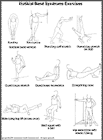
Iliotibial Band Syndrome Rehabilitation Exercises
You may do all of these exercises right away.
- Iliotibial band stretch (standing): Cross your uninjured leg in front of your injured leg and bend down and touch your toes. You can move your hands across the floor toward the uninjured side and you will feel more stretch on the outside of your thigh on the injured side. Hold this position for 15 to 30 seconds. Return to the starting position. Repeat 3 times.
- Iliotibial band stretch (side-leaning): Stand sideways near a wall, your injured leg toward the inside. Place the hand of your injured side on the wall for support. Cross your uninjured leg over the injured leg, keeping the foot of the injured leg stable. Lean into the wall. Hold the stretch for 15 seconds and repeat 3 times.
- Standing calf stretch: Facing a wall, put your hands against the wall at about eye level. Keep the injured leg back, the uninjured leg forward, and the heel of your injured leg on the floor. Turn your injured foot slightly inward (as if you were pigeon-toed) as you slowly lean into the wall until you feel a stretch in the back of your calf. Hold for 15 to 30 seconds. Repeat 3 times. Do this exercise several times each day.
- Hamstring stretch on wall: Lie on your back with your buttocks close to a doorway, and extend your legs straight out in front of you along the floor. Raise the injured leg and rest it against the wall next to the door frame. Your other leg should extend through the doorway. You should feel a stretch in the back of your thigh. Hold this position for 15 to 30 seconds. Repeat 3 times.
- Quadriceps stretch: Stand an arm's length away from the wall, facing straight ahead. Brace yourself by keeping the hand on the uninjured side against the wall. With your other hand, grasp the ankle of the injured leg and pull your heel toward your buttocks. Don't arch or twist your back and keep your knees together. Hold this stretch for 15 to 30 seconds. Repeat 3 times.
- Quadriceps isometrics: Sitting on the floor with your injured leg straight and your other leg bent, press the back of your knee into the floor by tightening the muscles on the top of your thigh. Hold this position 10 seconds. Relax. Do 3 sets of 10.
- Wall squat with a ball: Stand with your back, shoulders, and head against a wall and look straight ahead. Keep your shoulders relaxed and your feet 1 foot away from the wall and a shoulder's width apart. Place a rolled up pillow or a soccer-sized ball between your thighs. Keeping your head against the wall, slowly squat while squeezing the pillow or ball at the same time. Squat down until you are almost in a sitting position. Your thighs will not yet be parallel to the floor. Hold this position for 10 seconds and then slowly slide back up the wall. Make sure you keep squeezing the pillow or ball throughout this exercise. Repeat 10 times. Build up to 3 sets of 10.
- Hip adduction: Tie a loop in one end of the tubing and slip the loop around the ankle of your injured side. Make a knot in the other end of the tubing and close the knot in a door. Stand sideways to the door, with your uninjured leg away from the door. Bring your injured leg across your body sideways, crossing over your uninjured leg and stretching the tubing. Return to the starting position. Do 3 sets of 10.
- Knee stabilization: Wrap a piece of elastic tubing
around the ankle of your uninjured leg. Tie the tubing
to a table or other fixed object.
- Stand on your injured leg facing the table and bend your knee slightly, keeping your thigh muscles tight. While maintaining this position, move your uninjured leg straight back behind you. Do 3 sets of 10.
- Turn 90° so your injured leg is closest to the table. Move your uninjured leg away from your body. Do 3 sets of 10.
- Turn 90° again so your back is to the table. Move your uninjured leg straight out in front of you. Do 3 sets of 10.
- Turn your body 90° again so your uninjured leg is closest to the table. Move your uninjured leg across your body. Do 3 sets of 10.
Hold onto a chair if you need help balancing. This exercise can be made even more challenging by standing on a pillow while you move your uninjured leg.
Written by Tammy White, M.S., P.T., for McKesson Health Solutions LLC.
Published by McKesson Health Solutions LLC.
This content is reviewed periodically and is subject to
change as new health information becomes available. The
information is intended to inform and educate and is not a
replacement for medical evaluation, advice, diagnosis or
treatment by a healthcare professional.
Copyright © 2003 McKesson Health Solutions LLC. All rights reserved.

